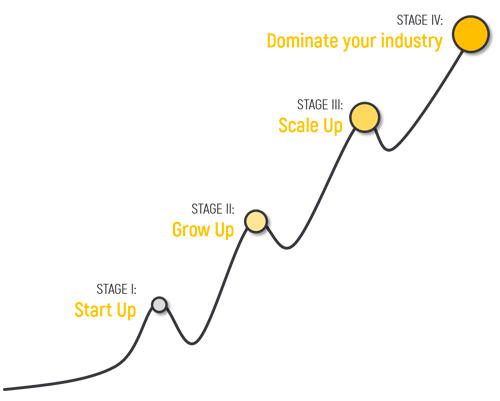Growing and scaling a business as it begins to gain traction is an exciting period for any entrepreneur. It can also be a nerve-wracking experience for business owners who want to make the right decisions, while figuring out what’s working and what needs to be improved. If your business is entering a period of growth, you’ll want to be prepared for the most common challenges faced and top issues when growing and scaling your business.
Here we can see the different stages of expansion and how growth typically occurs before scaling. Regardless, while there are differences between growing and scaling, the issues listed below will likely be encountered by businesses undergoing expansion of any kind.
5 Challenges When Growing Your Business
Below, we’ve highlighted five common pain points to consider during a period of business expansion.
1. Waiting for the Right Time to Scale Your Business
It’s natural to have grand ambitions for your business, and you’ll want to stay a step ahead of your competition. However, when scaling your business, you need to ensure that you fully understand who you’re targeting with your product. You also need to iron out any known issues with your product or service before expanding it.
Some business leaders face problems when they attempt to scale without fully understanding their target market. This isn’t just about knowing who your audience is, but also whether there is sufficient demand in the market to justify the costs involved in upscaling. Scaling your business without first working out the answer to these questions could result in loss of revenue.
Hiring experienced business analysts to interrogate your business, its needs and its target market can help you to pinpoint gaps in your strategy, while providing useful business intelligence that you can use to plan and implement programs of change.
2. Ensuring Infrastructure Can Support Growth
In order to expand your business and its user or customer base, you need to have the necessary infrastructure in place. Simply expanding your subscribers threefold, for example, without investing in the necessary infrastructure could lead to crippling service outages that cost your business.
For example, imagine that you’re operating an ecommerce website, and you want to upscale. if you scale up the number of users accessing your service, but you haven’t given thought to the increased load on your systems, you could see website outages that harm your business. Business-critical systems must keep pace with growth in your user base.
Transforming your business infrastructure and IT systems is no small task, with changes and mistakes in particular being costly. That’s why many business leaders who are looking to scale will start a PMO (project management office) that can take responsibility for business transformation in a structured and efficient manner.
The PMO will typically fulfil another key role, which is governance. That is, implementing and recording detailed processes and documentation across the business that will drive further change.
3. Hiring Top Talent to Support Increased Workload
When you’re trying to scale a business, you need investment in order to develop critical business areas, such as those mentioned above. In such a period of spending, it can be tempting to look to other areas where you can cut back or avoid investing additional profit.
However, with any business expansion, you’re going to need to bring on additional talent in order to keep up with the increased workload that upscaling brings. Trying to save money in this area can lead to a dip in performance and output, and thus customer satisfaction.
4. Adapting to Business Change
When you’re running a business, you can’t choose to avoid change; it’s a case of adapting or failing. Often, businesses have to redirect their focus into new technologies, products and services to remain competitive. However, with the business undergoing such a radical transformation, you’ll have little time to dedicate to this time-consuming task.
Failing to pre-empt and adapt to a changing market can be the result of numerous factors, including poor forward planning, insufficient resources and resistance to change. That’s why it’s important to monitor your sales trajectory and revenue, as these will be your key indicators of growth or a need for adaptation.
An experienced PMO function following an Agile transformation framework can ensure that these opportunities are not missed. With a diverse team of analysts and product managers looking after your product or service’s direction, you’ll have more time to focus on critical business issues at a higher level.
5. Managing Your Time Effectively
Time management is a learned skill that can be hard to master. During periods of substantial transformational change, it can feel even more challenging, as you’ll be managing finances, new clients, your management and leadership team and more. When you’re stretched so thin, some areas of the business can fall by the wayside.
Since you founded the business, you’re likely going to want to remain in control of everything. Unfortunately, it’s not sustainable in the long term, and you’ll have to hire a trusted team to which you can delegate responsibilities. When you hire a project management function to implement change, human resources staff to manage employees and a marketing team to analyse and understand your market, you’ll start to see a tangible difference in the efficiency of your organisation.
Want to find out more about how AMO can help with your project management capability? Have a look here (https://agilemanagementoffice.com/consult/) how our team can help yours reach their full project management potential. If you want to know more, contact us on contact@agilemanagementoffice.com

